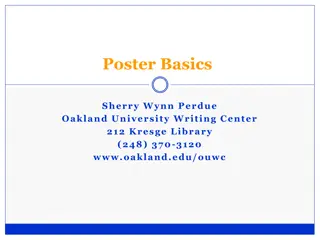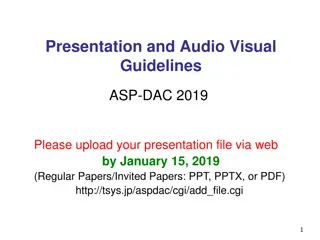Virginia Statewide Acquired Brain Injury Assessment 2013
This report conducted by Virginia Commonwealth University aimed to assess the needs and resources for individuals with acquired brain injuries (ABI) in Virginia. The study identified service needs, gaps, and available resources for ABI survivors and their families/caregivers. Data was gathered through focus groups, surveys targeting survivors, caregivers, family members, and professionals serving the ABI community. The demographics of participants and where they reside within Virginia were also outlined, providing insights into the survivor population.
Download Presentation

Please find below an Image/Link to download the presentation.
The content on the website is provided AS IS for your information and personal use only. It may not be sold, licensed, or shared on other websites without obtaining consent from the author. Download presentation by click this link. If you encounter any issues during the download, it is possible that the publisher has removed the file from their server.
E N D
Presentation Transcript
2013 Virginia Statewide Acquired Brain Injury Needs and Resources Assessment Virginia Commonwealth University Survey and Evaluation Research Laboratory
FUNDING Funding was provided through Grant Number 6 H21MC06763-05-02, and awarded to the Virginia Department for Aging and Rehabilitative Services by the U.S. Department of Health and Human Services, Health Resources and Services Administration.
OBJECTIVES To identify service needs of individuals with ABI and their families/caregivers (i.e., Health, Rehabilitative and Therapeutic Services, Housing, Employment) To better understand the existing resources and programs in order to identify gaps in services for individuals with ABI in each of the regions within Virginia
ASSESSMENT ACTIVITIES 6 focus groups for caregivers and survivors Web and Mail Survey targeting Survivors Web and Mail Survey targeting Caregivers and Family Members Web and Mail Survey targeting Professionals who serve ABI Community
PARTICIPANTS Focus groups 22 ABI Survivors Participated 19 Caregivers/Family Members Participated Survivor Survey 213 Survivors Completed Caregiver Survey 182 Caregivers Completed a survey for themselves and the Survivor for who they give care Provider Survey 60 Providers Completed, 53 were included in analysis
Where Participants Reside DARS District 30% 25% 23% 23% 25% 22% 21% 21% 18% 20% 16% 15% 11% 9% 10% 7% 5% 5% 0% Tidewater Capitol Northern Virginia Blue Ridge Southern Southwest Survivor Survey Caregiver Survey
Survivor Description 75% Attended at Least Some College 51% Male and 49% Female Mean Age was 47 87% were Caucasian 65% of Survivors were Employed Full time at the time of their injury, only 21% reported working Full-time now
Caregiver Description Nearly 3/4ths were 50 or older Mean Age 56 82% were female 87% were Caucasian 51% were the Parent of the Survivor, with another 24% being the Spouse of the Survivor
Provider Description 57% were private, 43% were public 37% only served Survivors 61% serve both Survivor and Caregivers/Family Members
Severity of Injury 80% 68% 70% 58% 60% 50% 40% 30% 25% 22% 17% 20% 10% 10% 0% Mild Moderate Severe Survivor Survey Caregiver Survey
Problems Resulting from Injury 94% Cognitive Disability 86% 74% Behavior or Emotional Problem 70% 74% Physical Disability 69% 69% Medical Problem 66% 64% Communication Disorder 55% 15% Other 18% 0% 20% 40% 60% 80% 100% Caregiver Survey Survivor Survey
What we found out about Needs
ABI Caregivers Need More Help Yes, need help 30% No 46% Yes, need more help 24%
Slightly less than Half of Survivors are NOT Living Where They Want No 42% Yes 58%
The Majority of Caregivers and Survivors Reported NOT receiving Information/Advice After ABI 70% 61% 60% 53% 50% 40% 29% 30% 25% 22% 20% 10% 10% 0% Yes No Not Sure Survivor Survey Caregiver Survey
A Third of both Survivors and Caregivers were Unsatisfied with the Information/Advice they Received Immediately after ABI 40% 34% 34% 33% 35% 30% 25% 25% 21% 20% 16% 13% 15% 10% 10% 10% 4% 5% 0% Very Satisfied Somewhat Satisfied Somewhat Unsatisfied Very Not Sure Unsatisfied Survivor Caregiver
Paid Assistant Services (PAS) 28% of survivors and 51% of caregivers reported that the survivor needs physical assistance to carry out their daily activities (i.e. Bathing, Dressing, Preparing Meals) 44% of Survivors and 58% of Caregivers, who need help, report using a PAS Of those not currently using a PAS, 84% of Survivors and 53% of Caregivers report that they would be interested in having a PAS PAS needed for an average of 40 hours reported by both Survivors and Caregivers
ABI Training Level of Staff Not at all 2% Under- trained 25% Highly trained 34% Moderately trained 40%
Worry about Future Living Arrangement 60% 49% 50% 37% 40% 35% 32% 30% 20% 18% 20% 9% 10% 2% 0% I worry They worry Both worry Neither worry Survivor Caregiver
Areas Where Future Services May be Needed 100% 89% 90% 77% 80% 71 % 70% 59% 60% 50% 47% 50% 40% 30% 20% 10% 0% Medical, Therapy, or Rehabilitative Services Education or Employment Services Community Living Support Survivor Caregiver
Services Offered By Providers Percent of Providers who Offer Services in This Area Rehabilitation Services 89% Education/Employment services 76% Medical or Therapeutic services 76% Community living support services 63% Residential Services 52% 0% 10% 20% 30% 40% 50% 60% 70% 80% 90% 100%
Greatest Gaps in Service as Perceived by Providers Provider Survey Behavioral Therapy (52%) 1 Supported Living (48%) 2 Group Residence (46%) 3 Residential Rehabilitation Facility (39%) 4 Assisted Living Facility (39%) 5 Life Skills Training (39%) 6
Do you currently need service? No Yes Next Question Are you receiving? Yes No Other Can t Afford Does it meet needs? Not Available Yes No
Greatest Unmet Needs Reported were Survivor Survey Caregiver Survey Cognitive therapy (36%) Cognitive therapy (59%) 1 Individual counseling (36%) 2 Activities with other ABI survivors/ recreational activities (45%) Behavioral supports (44%) 3 Alternative services (acupuncture, massage therapies, etc.) (30%) Medical services that address the effects of ABI injury (30%) 4 Individual counseling services (42%)























